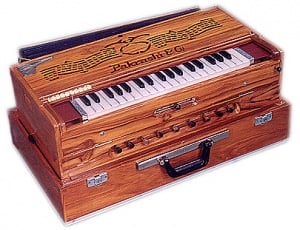Harmonium
The Harmonium is a small, manually-pumped musical instrument using fixed reeds to create the basic sounds. There are two main types of harmonium: a foot-pumped version that resembles a small organ, and a hand-pumped portable version that can fold up for easy transport. The hand-pumped portable version is very popular with Kirtan Jathas along with the Tabla and these form the main type of instruments used by Ragis during the performance of Kirtan.
The Harmonium was invented in Europe in Paris in 1842 by Alexandre Debain, though there was concurrent development of similar instruments elsewhere. During the mid-19th century missionaries brought hand-pumped harmonium to India, where it quickly became popular due to its portability and its low price. Its popularity has stayed intact to the present day, and the harmonium remains an important musical instrument in many types of Indian music, as well as being commonly found in Indian homes.
In Indian music, the Harmonium is considered to be one of the most versatile instruments. The harmonium is used in classical, semi-classical, and devotional music. It is usually used as an accompanying instrument for vocalists in classical music. However, some musicians have begun playing the harmonium as a solo instrument. One of the largest pioneers of this style is Pandit Tulsidas Borkar of Mumbai. More and more music students are learning in this fashion.
Harmoniums consist of banks of reeds (metal bands which vibrate when air flows over them), a pumping apparatus, stops for drones, and the keyboard. The harmonium functions mostly like an accordion. In order to play the instrument, one must pump air into the instrument and press the desired keys. The sound of the harmonium is unique, and improves over time as the instrument ages.
The number of reed banks is up to the particular person. Some harmoniums use 1 reed, 2 reeds, and 3 reeds. This refers to the number of reed sets there are in the instrument. Classical instrumentalists usually use 1-reed harmonium, while a musician who plays for a qawaali (Islamic devotional singing) usually uses a 3-reed harmonium.
External links
- Professional harmoniums
- Beginners harmoniums
- Information on Professional Harmonium
- The Classical Harmonium
- Indian Harmonium Page

